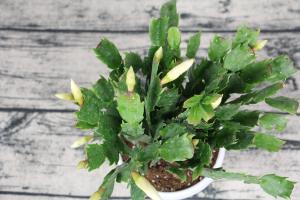Introduction
Tomatoes are one of the most commonly grown vegetables in home gardens and commercial farms. They are easy to grow, provide an abundance of fruit, and are packed with essential nutrients. However, like all plants, tomatoes are susceptible to plant diseases and pests. In recent years, there has been an increasing interest in using companion planting to help prevent these problems. In this article, we will explore whether certain plants can help tomatoes in their growth and development.
Benefits of Companion Plants for Tomatoes
Companion planting is the practice of growing different plants close to each other to provide mutual benefits. When used with tomatoes, certain plants can help protect them from pests and diseases, improve soil quality, and increase yields. For example, planting marigolds or basil near tomatoes can help repel nematodes and insect pests such as tomato hornworms. Additionally, planting legumes such as beans or peas near tomatoes can improve soil health by fixing nitrogen, which can be beneficial for growth.
Plants That Can Help Tomatoes
While many plants have been used as companion plants for tomatoes, some have been shown to be particularly effective. Some plants that can help tomatoes include:
Marigolds – These bright flowers have been shown to repel pests, particularly nematodes, which can damage tomato roots.
Basil – This herb has a strong scent that can deter insects like tomato hornworms, aphids, and whiteflies.
Borage – This plant attracts beneficial insects such as bees, which can increase pollination and fruit production in tomatoes.
Chives – These plants produce a strong odor that can repel pests such as aphids and spider mites.
Nasturtiums – These flowers attract beneficial insects such as ladybugs and hoverflies, which can help control pests like aphids and whiteflies.
Additional Tips for Companion Planting with Tomatoes
While companion planting can be a beneficial practice for tomatoes, it is important to keep a few things in mind. Firstly, not all plants make good companions for tomatoes. For example, planting tomatoes near potatoes can increase the risk of blight, a fungal disease that can affect both plants. Additionally, companion plants should not be allowed to overshadow or compete with the tomato plants for nutrients and sunlight.
Lastly, it is important to consider the needs of the companion plants when designing a companion planting scheme for tomatoes. For example, plants that fix nitrogen may require additional water or fertilizer to support their growth, which can affect the overall health of the garden. With careful planning and attention to detail, however, companion planting can be a useful tool in growing healthy and productive tomato plants.
Conclusion
While there are many factors that go into growing healthy and productive tomato plants, companion planting can be a useful tool for preventing pests and diseases, improving soil health, and increasing yields. By planting certain plants near tomatoes, such as marigolds or basil, gardeners can help protect their plants while also promoting the growth of beneficial insects and other soil microorganisms. When used in combination with other good gardening practices, such as regular watering and fertilization, companion planting can help ensure that tomatoes thrive in the garden.

 how many times do yo...
how many times do yo... how many planted tre...
how many planted tre... how many pine trees ...
how many pine trees ... how many pecan trees...
how many pecan trees... how many plants comp...
how many plants comp... how many plants can ...
how many plants can ... how many plants and ...
how many plants and ... how many pepper plan...
how many pepper plan...































